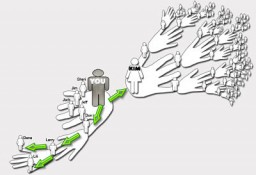Some job experts say that more jobs are now filled online through LinkedIn (LI) than all the job boards combined.
LI is, without a doubt, a major player in online job search; it is here to stay; and it’s influence continues to grow. If LI were a country, it would be the 12the most populous country in the world! I recommend that most job searchers learn to use it. Why?
Hiring practices have changed a lot in the past 10 years because we have moved from an expansionary to a recessionary economy; instead of growing rapidly, the
economy is shrinking slowly.
In an expansionary economy, employers have to hire a lot of people quickly in
order to compete and prosper from selling their products and services. This
creates a “sellers market” with an advantage for job searchers because the
demand for skilled labor outstrips supply.
For example, during the hi-tech boom, employers were looking for skilled labor
in order to push their products out the door. Job searchers could throw their
resumes online using job boards, or post directly onto company websites, and
if they had skills, experience or training that matched employer needs, they
would get calls from recruiters or employers in a timely manner.
We are in a very different economy now. Organizations are not expanding, they
are cutting back, and no longer have the same need to hire lots of new
employees. Supply now exceeds demand. To throw your resume online and expect
the same response that you may have enjoyed during the hi-tech bubble is an
unrealistic expectation.
And yet, that is exactly what I am hearing these days from so many clients.
Their last job search experience occurred during the hi-tech bubble when it was
relatively easy to get a job through an online job search.
But now, we live with a recessionary economy, a “buyers market” for employers,
who no longer have an urgent need to go online to find employees. Instead,
they can afford to wait for candidates to come to them…by loading a resume
onto the company website, or through referrals, or through networking.
Employers can take the time to be picky and choosy. They no longer need job
boards or recruiters to the same extent in order to fill the gap between demand
and supply.
This is the reason, at least in part, for the success of LI. Many managers
themselves are going online to recruit candidates. They are bypassing
recruiters, even their own HR departments (which have been seriously downsized
as companies cutback overhead), and using the features of LI to troll for
candidates.
Therefore, it makes sense for job searchers to leverage themselves into the
hiring process through LI, which is designed to help managers find you and vice
versa. How?
Think strategically
You have to join LI in order to use it, but it’s free. Scroll to the bottom of
their page and select their Learning Center link, which will help you Get
Started and learn how to use LI efficiently and effectively.
You can also use a search engine and type in the Q: How to use LinkedIn for job
search? And get lots of free advice from videos, webinars, articles, books, and
more.
As the picture with this article shows, you have hundreds, thousands, of people
in your goodwill network who want to help. Your job is to make it easy for
them to do so. LI can help.
I specialize in helping clients with job change, with transitions from one
career space to another. So, before getting active on LI, I advise them to
think about how they want potential employers to view them.
Do not use LI like a job board. It’s not about posting your resume. It’s a
business networking tool and designed for that purpose.
“Should I quit my job?” is not the first Q to ask yourself when making a career
change. Instead, think strategically about what you want to do and where to do
it. Where and what are the two Qs that I help my clients answer in very
specific terms.
LI then can help translate those answers into real job opportunities in real
work settings by identifying communities of interest. LI will facilitate
connections in that career space. LI is about managing relationships in a way
that facilitates your professional goals to break into that space.
Have a clear picture of your next career space and how you fit into it. Know
your value proposition and stay on message or, in the parlance of social media,
stay on brand. Consistency is the key! It’s about packaging and positioning
yourself online according to your right work, to the kind of work you most want
to do, and that best suits you.
There is no need to rush into a public profile. Before you build it, plan it!
Think strategically.


Glad to hear! And appreciate the feedback on fast upload, cheers!